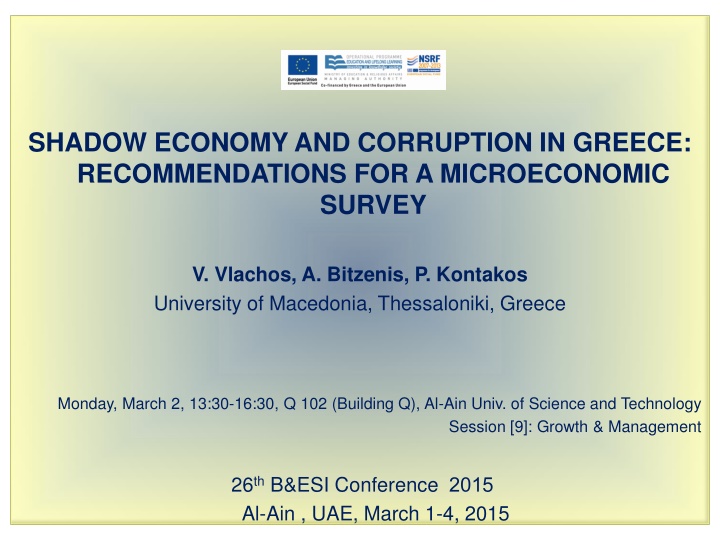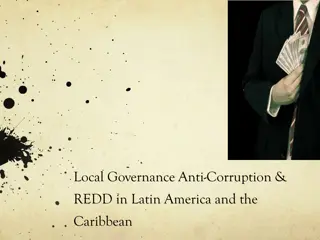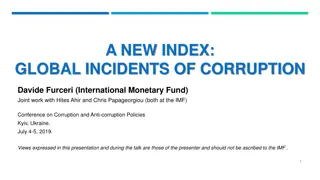Shadow Economy and Corruption in Greece: Recommendations for Microeconomic Survey
Our project aims to research and measure various aspects of the shadow economy in Greece, including corruption, tax evasion, and illegal work. By analyzing questionnaire results and conducting economic experiments, we seek to address these pressing issues. The impact of shadow economy actions on unemployment and GDP per capita is also explored, reflecting the complex economic landscape in Greece.
Download Presentation

Please find below an Image/Link to download the presentation.
The content on the website is provided AS IS for your information and personal use only. It may not be sold, licensed, or shared on other websites without obtaining consent from the author.If you encounter any issues during the download, it is possible that the publisher has removed the file from their server.
You are allowed to download the files provided on this website for personal or commercial use, subject to the condition that they are used lawfully. All files are the property of their respective owners.
The content on the website is provided AS IS for your information and personal use only. It may not be sold, licensed, or shared on other websites without obtaining consent from the author.
E N D
Presentation Transcript
SHADOW ECONOMY AND CORRUPTION IN GREECE: RECOMMENDATIONS FOR A MICROECONOMIC SURVEY V. Vlachos, A. Bitzenis, P. Kontakos University of Macedonia, Thessaloniki, Greece Monday, March 2, 13:30-16:30, Q 102 (Building Q), Al-Ain Univ. of Science and Technology Session [9]: Growth & Management 26thB&ESI Conference 2015 Al-Ain , UAE, March 1-4, 2015
Note: The current paper is presented under the auspices of the THALES Research Programme. THALES Programme has been co- financed by the European Union (European Social Fund - ESF) and Greek national funds through the Operational Program Education and Lifelong Learning of the National Strategic Reference Framework (NSRF). 2
Foreword to our Project Our aim is to research and measure all the various aspects of shadow economy in Greece, including corruption (-), tax evasion (+), tax avoidance (-), social contribution avoidance (+), undeclared and illegal work (+), self-consumption (+), tax morale level (-), tax compliance level (+), illegal and criminal acts (black or underground economy; money-laundering, human and drug trafficking, briberies / -, as a result of reduction of immigrants). It covers all economic agents in Greece, such as citizens and corporations (e.g. public servants and private individuals, companies and all professional categories, etc.) The research is also performed at sector levels, e.g. to identify the extent of tax evasion and corruption in the trading of oil in Greece. 3
Foreword to our Project (cont.) It measurement of Greek shadow economy but aims to the qualitative analysis of questionnaire results and the comprehension of the problem. does not aim to the precise percentage regarding the The implementation of our economic experiments (tax compliance games) involves at least 2,000 individuals and business owners (in majority small businesses). interviews, scientific games and The project aspires to achieve numerous objectives, among which the development of a relevant theoretical background, and perform cross-country comparisons at regional level, but also with country groups with advanced taxation systems. 4
Foreword to our Project (cont.) Greece is a great example since the literature review suggests contradictory conclusions regarding unemployment rate and GDP per capita with shadow economy actions and size. the correlation of In Greece, during the period 2008-2014, both unemployment increased from 8% to 27% and the GDP per capita decreased almost 25%. THALIS results show that corruption and the size and the volume of actions in shadow economy decreased not only as a percentage of GDP, but also in absolute volume due to the Memorandums adopted (Troica: ECB, EC, IMF), unemployment threat (enen in the public contraction/restructuring/transparency in public organizations and salaries reduction). sector, due to the 5
Agenda 1. Aim of the paper 2. Introduction 3. Size and determinants of the Greek shadow economy 4. Size and determinants of tax evasion in Greece 5. Undeclared work in Greece 6. Proposed econometric method & Questionnaire design for assessing the shadow economic activities and corruption in Greece 7. Conclusion 6
1. Aim of the paper To discuss the determinants of shadow economy and corruption in Greece as indicated by relevant studies. The concepts of tax evasion and informal labour (or undeclared work) are explored respectively. Our final aim is to propose a questionnaire approach for the collection of primary data that will reflect the typology of the Greek taxpayer and designate orientations for the econometric analysis of the data. 7
2. Introduction Based on a discussion about the alternative methods adopted by researches, the paper aims to introduce a multifaceted approach and research methodology in the assessment of shadow economy and corruption in Greece. A strong advantage of direct (microeconomic) measurement over indirect (macroeconomic) approaches is in their ability to: highlight directly the motives of engaging in shadow economic activities, reveal the supply, demand and remuneration of informal labour, and depict more accurately tax evasion across industries and income groups. 8
3. Size and determinants of the Greek shadow economy An early study concerning the determinants of tax evasion in Greece concludes that widespread tax evasion is largely due to the historical mistrust between the Greek state and its citizens. Despite the European integration experience, low tax morale (distrust in public institutions) is still a major cause for the inability of fiscal authorities to meet projected tax receipts goals. The frequently termed by the Greek media as the sport of tax evasion , describes the norm of evading taxes for personal gain, and can be understood through the absence of the social norm of tax compliance. Furthermore, the tax burden (both the direct and indirect) has also been considered of equal importance. 9
3. Size and determinants of the Greek shadow economy (cont.) A determinants of the Greek shadow economy highlights the tax and social security contribution burdens. non-empirical but more comprehensive approach to the Further, high unemployment rate, the entrance of immigrant workers, and poverty rates in some regions encouraged shadow economic activities. All the macroeconomic studies that estimate the size of the Greek shadow economy examine the country as a part of a broader (more than two digits) sample and underline in general, the determinants depicted in the findings of MIMIC approaches. E.g. Dell Anno et al. indicate that unemployment, social security contributions and self-employment are the main determinants of the size of the Greek shadow economy. 10
3. Size and determinants of the Greek shadow economy (cont.) Dell Anno et al. indicate that an inverse relationship prevails between the official GDP growth rate and that of the shadow economy and Katsios argues that there is a complementary relationship between corruption and the shadow economy. The Greek health care system, where patients frequently find themselves making under-the-table payments to access public services that are supposed to be free, is an ideal case study of the links between shadow economy and corruption in Greece. According to a study, 36% of the sample was found to have made an informal payment to a doctor irrespectively of their socio- economic characteristics, either due to lack of confidence in the service received (e.g. receiving receiving the service (e.g. doctor s demands, avoiding the queue). sub-standard care) or for 11
3. Size and determinants of the Greek shadow economy (cont.) 12
4. Size and determinants of tax evasion in Greece Tax evasion does not describe a value-adding activity and is the outcome of a financial transaction with the objective to conceal income. It has been estimated that foregone government revenues due to tax evasion amount to 31% of the Government deficit in 2009. Early estimations of tax evasion in Greece were about 4% of GDP and 45% of VAT revenues. For companies listed on the Athens Stock Exchange was estimated at 13% of total confirmed taxes. A more recent study considering indirect taxation as the driving force of tax evasion estimates tax evasion in Greece at 1.5% of GDP for 2010 and at 1.8% of GDP on average for 1999-2010. And who participates most in tax evasion? 13
4. Size and determinants of tax evasion in Greece (cont). A recent evaluation indicates that income from farming and self- employment earnings account for the bulk of tax evasion in Greece. This can be an explanation for the large preference for self- employment in Greece relative to the respective in the EU. Further, in the Greek corporate sector, as an example, many are those who argue that tax revenues of hundreds millions of euro a year are lost by the Greek government from illegal activity such as in fuel trading and shipping oil. The aforementioned arise from the luck of proper control mechanisms set by public authorities and facilitated by the provisions of Greek laws for tax-exempted allocation of shipping fuels. 14
5. Undeclared work in Greece According to the definition used by the European Commission since 1998 undeclared work is defined as "paid activities that are lawful as regards their nature but not declared to public authorities". Particularly, the definition excludes criminal activities which are treated in national law. Economic activities which arise from undeclared work tend to generate significant costs on various levels: they undermine the tax revenues and the contributions aimed to social security institutions, and also impact regular/fully secured employment. It is multi-faceted and its level of acceptance by the general public and the specific forms that can take varies among the different societies. It ranges, for example, from occasional baby-sitting to the construction of entire buildings with professionally organized networks of undeclared workers 15
5. Undeclared work in Greece (cont.) Accordingly, a wide array of methods has been developed to evaluate and understand the dimensions and causes of the phenomenon of undeclared work, particularly in the past three decades. These can be roughly grouped under two approaches: indirect and direct methods of measurement. Indirect (macroeconomic) methods are mainly intended at evaluating or estimating the size of undeclared work. Direct methods of measurement refer to survey-based methods that depend on information directly retrieved by the population. Their main contribution is that they can measure not only the size but also the structure and motivations of the participants involved in undeclared work. 16
5. Undeclared work in Greece (cont.) The reliability and validity of some indirect methods (particularly Schneider s monetary model calculations) has been criticized for measuring unrealistically high rates of undeclared work. On the other side, direct surveys tend to measure only the lower limit of the phenomenon since the participants during the conduct of a survey are usually unwilling to (fully) disclose their own relation with undeclared work, but also due to the difficulty of covering undeclared work by illegal immigrants in surveys. According to a Eurobarometer Survey, which was carried out in the EU-27 in 2013, countries with particularly high proportions of respondents who have purchased undeclared goods or services in the past year are Greece (30%), the Netherlands (29%), Latvia (28%), Denmark and Malta (23% in each) and Slovenia (22%). Interestingly enough, the overall rate shows no sign of shrinking. 17
5. Undeclared work in Greece (cont.) It has been put forward that the size of undeclared work ranges from one quarter to one third of the size of the shadow economy estimates derived from the MIMIC model. The application of this method indicates that undeclared work in Greece was at 6.8% of GDP in 2010, with an average of 8.1% for 1999-2010. Katsios argues that shadow production in Greece is relatively labor- intensive. The highest shares of undeclared work in 2010 belonged to immigrants ( 38%), individuals less than thirty years old (34%), family business assistants ( 21%) and part-time employees (31%). It concerns mostly the industries of construction, hotels & tourism activities, and trade , where employment has a temporary nature and occupations (such as household assistants) whose shadow economic activity is difficult to detect. 18
6. Proposed econometric method & Questionnaire design The discussion thus far indicates that the exploration of the primary data can be through a logit or probit analysis. A proposed innovation for accessing the incidence of shadow economic activities and corruption in Greece would be through propensity score matching. Propensity score matching would correct for sample selection bias due to observable differences between groups in terms of i.e. corruption victimization, long-term unemployment, tax morale, etc. A proposed questionnaire for the collection of the data has been developed by the authors of the paper based on the aforementioned grounds. This questionnaire approach has been employed in the pilot tests conducted by the authors, which ultimately aims to involve more than 2,000 individuals and business owners. 19
7. Conclusion The paper discusses the determinants of shadow economic activities and corruption in Greece as indicated by relevant studies. The concepts of tax evasion and informal labour (or undeclared work) are explored respectively. A propose econometric method and questionnaire design for accessing the incidence of shadow economic activities and corruption in Greece and reflect the typology of the Greek were accordingly proposed by the Authors. 20























